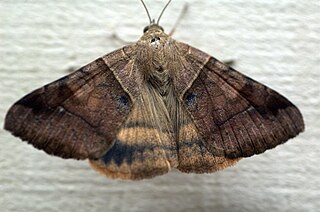
Mocis undata, the brown-striped semilooper, is a moth of the family Erebidae. The species was first described by Johan Christian Fabricius in 1775. It is found in the Afrotropical and Oriental regions, including India and Sri Lanka.

Aporandria is a monotypic moth genus in the family Geometridae described by Warren in 1894. Its single species, Aporandria specularia, was first described by Achille Guenée in 1857. It is found in Sri Lanka, India, Vietnam, Thailand, the Andamans, Peninsular Malaysia, Sumatra, Borneo, the Philippines and Sulawesi.
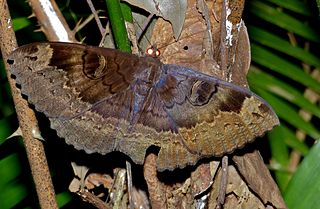
Erebus caprimulgus is a moth of the family Erebidae. It is found from the Oriental Region of India, Sri Lanka, Myanmar to Peninsular Malaysia, Sumatra and Borneo.

Ercheia cyllaria is a species of moth of the family Erebidae first described by Pieter Cramer in 1779. It is found in the Indian subregion, Sri Lanka, Taiwan, Japan, Indochina, Thailand, Peninsular Malaysia, Sumatra, Borneo, Seram and the Kai Islands.

Trigonodes hyppasia, the triangles or semi-looper, is a moth in the family Erebidae. The species was first described by Pieter Cramer in 1779. It is largely cosmopolitan, found throughout Borneo, Fiji, India, Nepal, Sri Lanka, São Tomé and Príncipe, Taiwan, Zimbabwe, northern Australia, and almost all African countries.

Ctenoplusia limbirena, the Scar Bank gem, or silver U-tail, is a moth of the family Noctuidae. It is found in south-western Europe, Africa, the Canary Islands, Arabia, the southern Himalayas, India, Sri Lanka, Indochina to south-eastern China, Taiwan, Sulawesi, Bali and Timor. In New Zealand, it has been established since 2011.

Chiasmia emersaria is a moth of the family Geometridae. The species was first described by Francis Walker in 1861. It is found in India, Nepal, northern Thailand, China, Sri Lanka, Japan and the Ryukyu Islands.

Semiothisa eleonora is a moth of the family Geometridae. It is found in south-west Asia, including India, Sri Lanka and Taiwan.
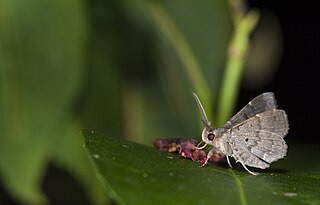
Bocana manifestalis is a moth of the family Erebidae. It was first described by Francis Walker in 1858. It is widespread from India through the Pacific.
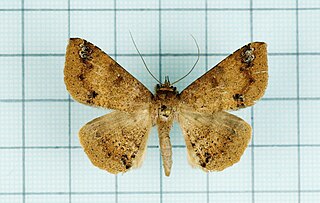
Ericeia inangulata, the sober tabby, is a moth in the family Erebidae. The species was first described by Achille Guenée in 1852. It is found in the Indo-Australian tropics of China, India, Sri Lanka, Myanmar, and the Marianas and Carolines, Fiji, Vanuatu, New Caledonia and Samoa.

Hypena lignealis is a moth in the family Noctuidae described by Francis Walker in 1866. It is found in Sri Lanka, Taiwan and Japan.

Hydrillodes lentalis is a species of moth of the family Erebidae described by Achille Guenée in 1854. It is found in south-east Asia and Australia (Queensland).

Hypena labatalis is a species of moth of the family Erebidae first described by Francis Walker in 1859. It is found in Australia, India and Sri Lanka.

Hypena obacerralis is a moth of the family Erebidae. It is found throughout Africa, the Middle East and South Asia and Malaysia.

Hypena conscitalis is a moth of the family Erebidae first described by Francis Walker in 1866. It is found throughout Africa, from Senegal to South Africa, in South and South-East Asia as well as in Australia and on some Pacific and Indian Ocean islands.

Harita rectilinea is a moth of the family Noctuidae described by Moore in 1882. It is found in India, Sri Lanka, Myanmar, Peninsular Malaysia and on Sumatra and Borneo.
Sauris hirudinata is a moth of the family Geometridae. It was described by Achille Guenée in 1858. It is found in Fiji, Sri Lanka, India, Hong Kong, as well as on Peninsular Malaysia and Borneo.
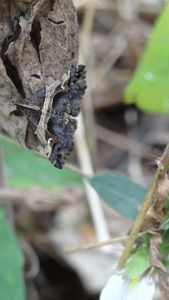
Bertula abjudicalis is a moth of the family Noctuidae first described by Francis Walker in 1859. It is found in India, Thailand, Laos, Vietnam, Taiwan and from Sri Lanka to Australia, where it has been recorded from New South Wales.
Ambia tenebrosalis is a moth in the family Crambidae. It is found in Sri Lanka.
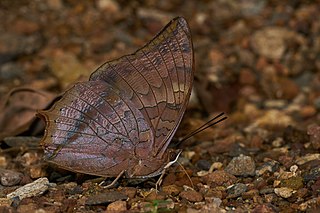
Charaxes psaphon, plain tawny rajah, is a butterfly in the family Nymphalidae. It was described by John Obadiah Westwood in 1847. It is found in the Indomalayan realm.

















